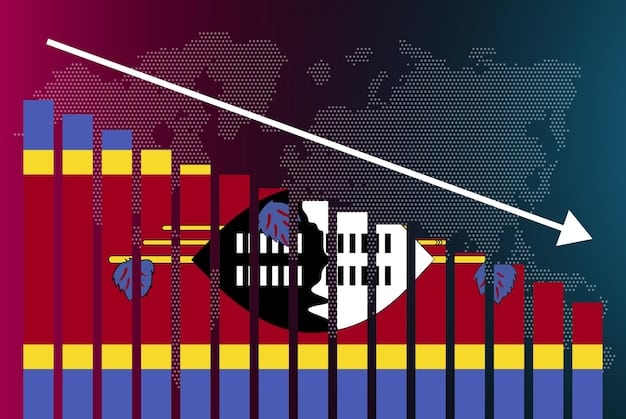Analyzing the Impact: Increased International Roster Spots in MLS Competition

Analyzing the impact of increased international roster spots on MLS competition involves assessing how the influx of global talent influences league dynamics, player development, and overall competitiveness.
Major League Soccer (MLS) has steadily grown in prominence, attracting players from around the globe. A key factor in this evolution is the number of international roster spots allocated to each team. Analyzing the impact of increased international roster spots on MLS competition reveals a complex interplay of benefits and challenges.
The Evolution of International Roster Spots in MLS
The regulations surrounding international roster spots in MLS have undergone significant changes over the years, reflecting the league’s evolving ambitions and philosophies. Understanding this historical context is vital for analyzing the impact of increased international roster spots on MLS competition.
Here’s a brief overview of how these regulations have evolved:
Early Years of MLS and Limited International Spots
In its early days, MLS had stricter limits on international players. The intention was to foster the development of domestic talent and build a league identity based on American players.
Gradual Increase in International Roster Spots
Over time, as the league matured and sought to enhance its competitiveness and appeal, MLS gradually increased the number of international roster spots allowed per team. This shift reflected a desire to attract higher-caliber players from around the world.
- Attracting Global Talent: Increasing roster spots provided teams with the flexibility to sign established international players, boosting the overall quality of play.
- Enhanced Competition: The influx of international players intensified competition within teams, pushing domestic players to improve and compete for starting positions.
- Growing Global Appeal: The presence of recognizable international names helped raise the profile of MLS internationally, attracting more fans and media attention.
The increase in international roster spots has significantly shaped the competitive landscape of MLS, fostering a blend of domestic and international talent. It has spurred debates about player development and the balance between nurturing local players and enhancing league quality through foreign acquisitions.

In conclusion, the evolution of international roster spot regulations reflects MLS’s ambition to become a prominent global soccer league. As the league continues to grow, these regulations will likely continue to adapt to balance the development of domestic talent with the desire to compete at the highest levels.
Impact on Competitive Balance
The allocation of international roster spots can significantly influence the competitive balance within MLS. Teams that effectively utilize these spots often gain a competitive edge, while those that don’t risk falling behind. Analyzing the impact of increased international roster spots on MLS competition reveals how strategically acquired international players can transform a team’s performance and standing in the league.
Here’s a breakdown of the effects on different teams:
Teams with Strategic International Signings
Teams that strategically invest in international players, identifying and acquiring talent that fits their tactical system and addresses specific needs, often see significant improvements in their performance.
Teams Lagging Behind
On the other hand, teams that fail to effectively utilize their international roster spots may struggle to keep pace. This could be due to poor scouting, ineffective integration of international players, or a lack of resources to attract top talent.
- Performance Disparities: The gap between the top and bottom teams can widen as some teams capitalize on their international roster spots while others flounder.
- Strategic Advantages: Teams with strong scouting networks and financial resources can secure higher-quality international players, gaining a competitive edge.
- Need for Investment: Teams must invest in scouting, coaching, and integration programs to maximize the value of their international players.
The strategic use of international roster spots can be a game-changer for MLS teams, influencing their competitive standing and overall performance. Successful teams prioritize strategic acquisitions and invest in creating an environment where international players can thrive, while others risk falling behind.
Influence on Player Development
The presence of international players in MLS has a multifaceted influence on player development, particularly for domestic players. Analyzing the impact of increased international roster spots on MLS competition demands a close examination of how international talent affects the growth and opportunities available to local players, and what steps can be taken to ensure a balanced ecosystem.
Here’s how international players impact player development:
Opportunities for Young Domestic Players
Some argue that limiting international roster spots could create more opportunities for young domestic players to gain playing time and develop their skills. However, a balanced approach may be more beneficial.
Mentorship and Skill Enhancement
The presence of experienced international players can provide mentorship opportunities for young domestic players, helping them improve their skills and tactical understanding.

The influx of international players brings new techniques, perspectives, and levels of competition that can push domestic players to elevate their game. Moreover, the opportunity to train and play alongside seasoned international professionals can provide invaluable learning experiences for young talents.
In summary, the influence of international players on player development is a delicate balance. While concerns about limited opportunities for domestic players are valid, the mentorship, competition, and skill enhancement provided by international players can contribute to their growth. Striking the right balance involves strategic roster management, investment in youth academies, and promoting a competitive environment that fosters the development of both domestic and international talent.
Economic Considerations
The economic aspects of increasing international roster spots are significant for MLS, impacting team finances, league revenue, and overall marketability. Analyzing the impact of increased international roster spots on MLS competition must take into account the financial implications for teams, including player salaries, transfer fees, and the potential returns on investment.
Here’s how increased international roster spots impact the economics of MLS:
Increased Revenue and Marketability
Bringing in well-known international players can boost ticket sales, merchandise revenue, and broadcast viewership, increasing the league’s overall marketability.
Managing Player Salaries and Transfer Fees
Teams must carefully manage player salaries and transfer fees to ensure financial stability while attracting top international talent.
Attracting notable international players can significantly enhance a team’s brand recognition. These high-profile signings can lead to increased sponsorship opportunities, attracting more investors and partners to the league. Additionally, marketing campaigns featuring international stars can resonate with a broader audience, boosting the league’s overall appeal.
In conclusion, the economic considerations surrounding increased international roster spots are crucial for the sustainable growth of MLS. While there are significant financial benefits to attracting international talent, teams must exercise careful financial planning and strategic investment to ensure long-term success. By balancing player acquisition costs with revenue generation, MLS can continue to grow as a financially stable and competitive league.
Fan Engagement and Cultural Diversity
The presence of international players enriches MLS by fostering fan engagement and promoting cultural diversity both on and off the field. Analyzing the impact of increased international roster spots on MLS competition requires examining how diverse player backgrounds contribute to a more vibrant and inclusive league ecosystem.
Here’s how international players affect fan engagement and cultural diversity:
Creating a More Inclusive Environment
The diversity that international players bring to MLS fosters a more inclusive environment, both in the locker room and in the stands.
Attracting a Global Fan Base
International players can attract fans from different cultural backgrounds, expanding the league’s global fan base.
- Enhanced Fan Experience: The blend of different playing styles and cultural backgrounds enhances the overall fan experience, making MLS more exciting and engaging.
- Community Building: Teams can engage with diverse communities through outreach programs and events that celebrate the cultural backgrounds of their international players.
- Increased Inclusivity: The presence of international players can make MLS more welcoming to fans from all over the world.
The integration of international players can also lead to enriching cultural exchanges. Teams that celebrate and embrace the diversity of their players can create a stronger sense of community among fans, both locally and globally. By creating a welcoming environment for players from different backgrounds, MLS not only enhances its competitive edge but also strengthens its position as a global league.
In summary, the presence of international players in MLS has a profound impact on fan engagement and cultural diversity. By fostering a more inclusive environment and attracting a global fan base, MLS can enhance its appeal and strengthen its position as a leading soccer league. Embracing diversity on and off the field is key to the league’s continued growth and success.
Future Implications and Potential Adjustments
Looking ahead, the future of international roster spots in MLS will likely involve adjustments to balance competitiveness, player development, and economic considerations. Analyzing the impact of increased international roster spots on MLS competition requires anticipating potential changes and their effects on the league’s overall ecosystem.
Here are some potential future implications and adjustments:
Potential Changes to Roster Rules
MLS may consider adjusting roster rules to encourage the development of domestic talent while maintaining a high level of competition.
Investing in Youth Academies
Further investment in youth academies could help produce more homegrown players, reducing reliance on international talent.
MLS may explore strategies to incentivize teams to develop and field domestic players. This could involve implementing bonus roster spots for teams that meet certain criteria for homegrown player participation. Additionally, creating a more robust pathway for young players to transition from youth academies to the first team would ensure a steady supply of domestic talent.
In conclusion, the future of international roster spots in MLS will require careful planning and strategic adjustments. By balancing competitiveness, player development, and economic considerations, MLS can continue to grow as a dynamic and successful soccer league. Anticipating future changes and proactively addressing potential challenges will be crucial to achieving long-term success and maintaining a vibrant and competitive league environment.
| Key Point | Brief Description |
|---|---|
| 🌍 Global Talent | Influx of international players improves league quality and competitiveness. |
| 📈 Economic Boost | International stars increase revenue, ticket sales, and overall marketability. |
| 🌱 Player Development | International players provide mentorship and enhance skill levels of domestic talent. |
| 🤝 Cultural Diversity | Diverse backgrounds create inclusive environment and attract global fan base. |
Frequently Asked Questions (FAQ)
▼
International roster spots are slots on an MLS team’s roster reserved for players who are not U.S. citizens or permanent residents. Each team is allocated a certain number of these spots.
▼
International players enhance the level of play by bringing diverse skills, experience, and competition. They can also attract more fans and increase the league’s global appeal.
▼
Some challenges include adapting to a new culture, language barriers, different playing styles, and varying climates, which can impact their performance and integration into the team.
▼
MLS aims to balance the two by setting limits on international roster spots while also investing in youth development programs to nurture domestic talent, ensuring a mix of both.
▼
The future likely involves adjustments to balance competitiveness, economic factors, and player development. MLS may refine roster rules to encourage homegrown talent while maintaining league quality.
Conclusion
In conclusion, analyzing the impact of increased international roster spots on MLS competition reveals a complex interplay of factors. The influx of global talent enhances competitiveness, boosts revenue, and fosters cultural diversity. However, it also presents challenges in balancing player development and managing costs. By carefully considering these aspects and making strategic adjustments, MLS can continue to thrive as a dynamic and globally recognized soccer league.





